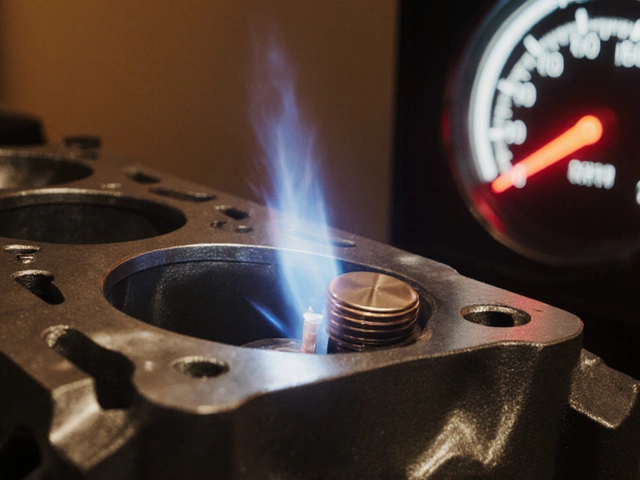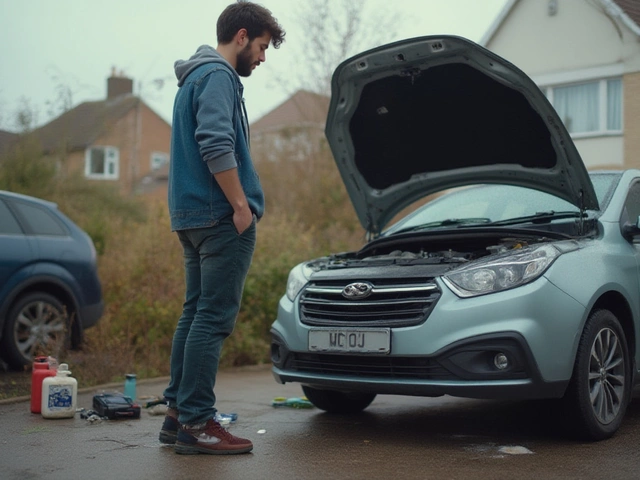Ever hit a pothole and felt like your spine got rearranged? Or notice your car bounces like a basketball over rough roads? Poor suspension comfort isn’t just annoying-it’s tiring, stressful, and even unsafe over time. The good news? You don’t need a race car budget to fix it. Most drivers can improve ride comfort with simple, affordable tweaks that actually work.
Understand What’s Worn Out
Most suspension problems start with worn-out shocks or struts. These parts don’t just absorb bumps-they control how your tires stay in contact with the road. When they wear out, your car doesn’t just bounce. It dives when braking, sways in corners, and feels floaty at highway speeds. Many drivers ignore this until they hear clunking or see oil leaking from the shocks.Check your shocks every 50,000 miles. A simple bounce test works: push down hard on one corner of the car. If it bounces more than once or twice, the shock is done. Replace them in pairs-never just one side. Mismatched shocks create uneven handling and make the ride worse.
Upgrade to Quality Replacement Shocks
Not all shocks are created equal. Cheap replacements might save you $50 upfront, but they’ll wear out faster and ride like a shopping cart with flat tires. Brands like Bilstein, KYB, and Monroe offer reliable upgrades that match or beat factory performance.For daily drivers, go for a gas-charged monotube shock. They handle heat better, resist fade on long drives, and give a firmer, more controlled feel without being harsh. If you drive mostly on smooth roads and want maximum comfort, consider a premium twin-tube design like the KYB Excel-G. They’re tuned for ride quality, not off-road abuse.
Check Your Springs
Springs hold up your car’s weight. Over time, they sag-especially if you’ve carried heavy loads or driven on rough roads. Sagging springs make your car sit lower, which changes the alignment and puts extra stress on shocks and control arms.Measure your ride height. Compare the distance from the center of the wheel to the bottom of the fender on both sides. If one side is more than half an inch lower, your springs are tired. Replacing them with stock-spec or slightly stiffer springs (like Eibach Pro-Kit) can restore proper geometry and improve ride feel. Avoid lowering springs unless you want a sportier, firmer ride.
Tires Matter More Than You Think
Your tires are the only part of the suspension touching the road. If they’re old, underinflated, or the wrong type, they’ll ruin even the best shocks.Check tire age. Rubber hardens after six years, even if tread looks good. Look for the DOT code on the sidewall-the last four digits tell you the week and year it was made. Replace tires older than six years.
Switch to tires with a higher aspect ratio (like 65 or 70 series instead of 50). Taller sidewalls absorb more impact. For example, swapping from 225/50R17 to 225/65R17 gives you more cushion without changing wheels. Also, avoid ultra-low-profile tires unless you’re racing. They’re great for looks, terrible for comfort.

Inspect Bushings and Control Arms
Rubber bushings connect suspension parts to the chassis. Over time, they crack, dry out, or turn to mush. When they fail, you get clunks, vibrations, and unpredictable steering.Jack up the car and wiggle the wheels side to side. If there’s more than a quarter-inch of play, bushings are likely worn. Check the control arm bushings, sway bar links, and strut mounts. Replacing them with polyurethane bushings (like Energy Suspension) adds durability without making the ride harsh. Avoid solid metal bushings-they’ll turn your car into a jackhammer.
Wheel Alignment and Tire Balance
Misaligned wheels don’t just eat up tires-they make the car pull to one side and feel twitchy over bumps. After replacing suspension parts, get an alignment. Even if you didn’t touch the alignment, it’s smart to check it every 10,000 miles or after hitting a major pothole.Also, unbalanced tires cause vibrations that feel like suspension problems. If your steering wheel shakes at 60 mph, get the tires rebalanced. A $15 balance job can make your ride feel brand new.
Avoid These Common Mistakes
- Don’t install stiffer springs hoping for better comfort. Stiffer springs make bumps feel sharper, not softer.
- Don’t mix old and new shocks. Always replace in pairs or all four at once.
- Don’t ignore squeaks or clunks. They’re early warning signs-not just noise.
- Don’t buy used shocks. They’re worn out and unsafe.
- Don’t skip a wheel alignment after suspension work. It’s not optional.

Real-World Example: A 2018 Honda Civic
A friend of mine had a 2018 Civic with 72,000 miles. The ride felt like driving over gravel even on smooth roads. Shocks were original, tires were 7 years old, and the rear springs were sagging. He replaced both front and rear shocks with KYB Excel-G, installed new Bridgestone Turanza tires (205/60R16), replaced the rear springs with OEM replacements, and did a full alignment. The cost was about £450. Afterward, the car felt like it had 10,000 miles on it. No more spine jolts. No more wobbling on highway seams. Just quiet, smooth cruising.What About Air Suspension?
Air suspension systems can adjust ride height and firmness-but they’re expensive and complex. They’re great for luxury cars or vehicles that carry heavy loads, but for most daily drivers, they’re overkill. If your car doesn’t come with air suspension from the factory, don’t retrofit it. The cost, maintenance, and failure risk aren’t worth it. Stick with proven coil spring and shock setups.When to Call a Pro
If you’re not comfortable lifting the car, removing wheels, or using spring compressors, hire a mechanic. Suspension work involves heavy parts and high tension. One mistake can lead to a dangerous failure. Look for shops that specialize in suspension-not just general repair. Ask if they use OEM or quality aftermarket parts, and get a written estimate before they start.Final Tip: Drive Smarter
No suspension upgrade fixes bad driving habits. Slow down over bumps. Avoid potholes when you can. Don’t carry unnecessary weight in the trunk. Drive smoothly. These habits extend the life of your suspension and keep your ride comfortable longer.How often should I replace my suspension shocks?
Most shocks last between 50,000 and 100,000 miles, but it depends on your driving. If you drive mostly on rough roads, replace them around 50,000 miles. Check them every 25,000 miles with a bounce test. If the car bounces more than twice, it’s time.
Can I improve suspension comfort without spending a lot?
Yes. Start with new tires in a taller sidewall profile, then replace worn shocks. These two steps alone can make a huge difference. A full alignment and bushing replacement add more comfort for under £300. Avoid expensive upgrades like air suspension unless your car already has it.
Do softer shocks mean a smoother ride?
Not always. Too soft shocks let the car wallow and bounce. The goal is balance-enough damping to control movement without being stiff. Gas-charged monotube shocks often provide the best compromise for daily driving. Look for models labeled for comfort, not performance.
Why does my car still feel bouncy after replacing shocks?
You might have worn springs, bad bushings, or unbalanced tires. Shocks control motion, but springs hold weight. If the springs are sagging, the shocks can’t work properly. Check tire pressure and age too. Old tires lose their ability to absorb shock.
Is it safe to drive with worn suspension?
Not for long. Worn suspension reduces braking efficiency, increases stopping distance, and makes the car harder to control in emergencies. It also wears out tires faster and can damage other parts like steering components. Replace worn parts before they become a safety risk.
Improving suspension comfort isn’t about buying the most expensive parts. It’s about fixing what’s broken, choosing the right replacements, and maintaining what you’ve got. Do it right, and your daily drive turns from a chore into something you actually enjoy.






